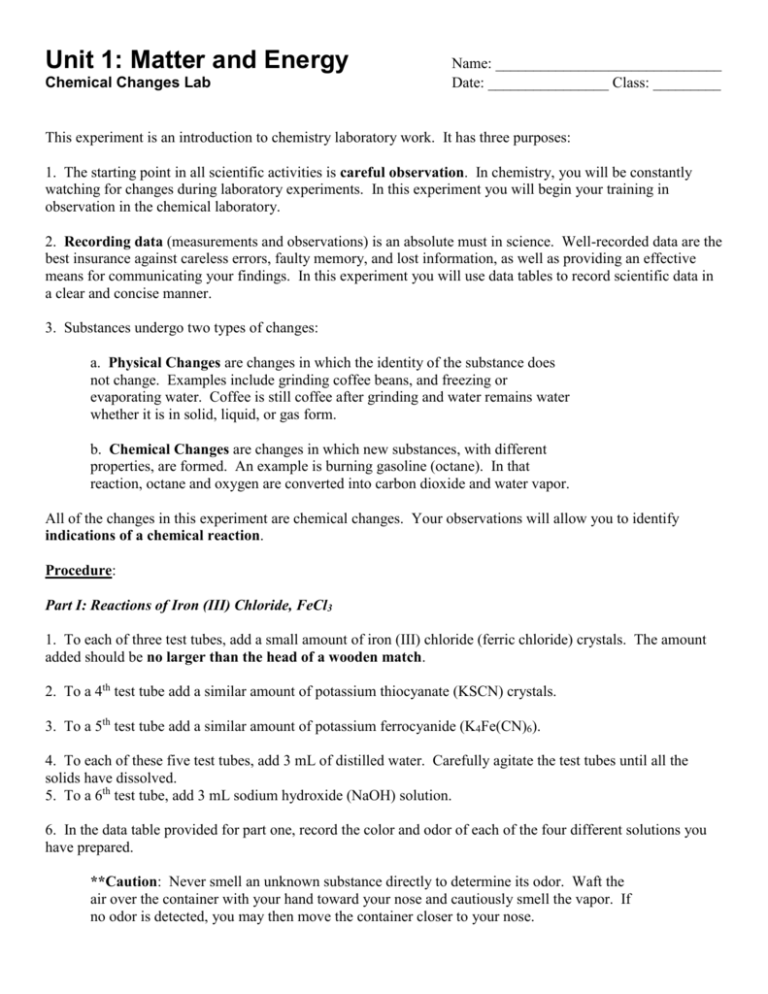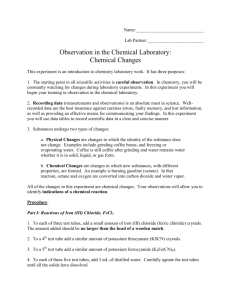Chemical Changes Lab with Data
advertisement

Unit 1: Matter and Energy Chemical Changes Lab Name: ______________________________ Date: ________________ Class: _________ This experiment is an introduction to chemistry laboratory work. It has three purposes: 1. The starting point in all scientific activities is careful observation. In chemistry, you will be constantly watching for changes during laboratory experiments. In this experiment you will begin your training in observation in the chemical laboratory. 2. Recording data (measurements and observations) is an absolute must in science. Well-recorded data are the best insurance against careless errors, faulty memory, and lost information, as well as providing an effective means for communicating your findings. In this experiment you will use data tables to record scientific data in a clear and concise manner. 3. Substances undergo two types of changes: a. Physical Changes are changes in which the identity of the substance does not change. Examples include grinding coffee beans, and freezing or evaporating water. Coffee is still coffee after grinding and water remains water whether it is in solid, liquid, or gas form. b. Chemical Changes are changes in which new substances, with different properties, are formed. An example is burning gasoline (octane). In that reaction, octane and oxygen are converted into carbon dioxide and water vapor. All of the changes in this experiment are chemical changes. Your observations will allow you to identify indications of a chemical reaction. Procedure: Part I: Reactions of Iron (III) Chloride, FeCl3 1. To each of three test tubes, add a small amount of iron (III) chloride (ferric chloride) crystals. The amount added should be no larger than the head of a wooden match. 2. To a 4th test tube add a similar amount of potassium thiocyanate (KSCN) crystals. 3. To a 5th test tube add a similar amount of potassium ferrocyanide (K4Fe(CN)6). 4. To each of these five test tubes, add 3 mL of distilled water. Carefully agitate the test tubes until all the solids have dissolved. 5. To a 6th test tube, add 3 mL sodium hydroxide (NaOH) solution. 6. In the data table provided for part one, record the color and odor of each of the four different solutions you have prepared. **Caution: Never smell an unknown substance directly to determine its odor. Waft the air over the container with your hand toward your nose and cautiously smell the vapor. If no odor is detected, you may then move the container closer to your nose. NOTE: You should use the following terms, when applicable, in your data tables: Clear: Transparent. You can see directly through it (like water, Kool-aid). Colored/Colorless: Things that are clear are either colored or colorless. Water is clear and colorless. Kool-aid is clear and colored. Precipitate (ppt): A solid that is present in a solution is a ppt. Either appears as visible particles or as cloudiness. Eventually, a ppt will settle to the bottom of the container. 7. Mix pairs of solutions in the following ways and record all your observations in the data table (note any temperature changes by feeling the test tubes with your fingers): FeCl3 (#1) + KSCN (#4) FeCl3 (#2) + K4Fe(CN)6 (#5) FeCl3 (#3) + NaOH (#6) 8. Pour the contents of the test tubes down the drain and wash all materials thoroughly. Data Table I: Reactions of Iron (III) Chloride Test Tube # Solution 1,2,3 FeCl3 4 5 6 Color Orange and clear Odor Smells like metal Reaction with FeCl3 Clear and Colorless None Turned blood red Clear and Colorless None Color turned dark blue Clear and Colorless None Green floaties/solids appeared in the solution KSCN K4Fe(CN)6 NaOH Part II: Reactions of Nitric Acid (HNO3) 1. To each of three small test tubes, add 3 mL of nitric acid. **Caution: Nitric acid burns skin and is destructive to clothing. Any spilled on your skin may leave a yellow stain. Alert your teacher if any spills occur. 2. Test the reaction of the acid to red and blue litmus paper. To do this, dip a clean stirring rod into one of your test tubes and touch it to a piece of litmus paper. 3. Obtain small pieces of magnesium, tin, and copper. 4. One at a time, add the metal pieces to a different test tube of nitric acid. If there is no immediate reaction, allow it to stand and proceed to the next metal. 5. Discard the contents of the test tubes down the sink. Unreacted metal pieces should NOT be washed down the drain. Rather, pick them up with forceps and throw the pieces away. 6. Wash all materials thoroughly. Data Table II: Reactions of Nitric Acid Reaction of Nitric Acid with: Observations No change in color of paper Red Litmus Blue Litmus Paper turned from blue to red upon contact with Nitric Acid Magnesium (Mg) The metal began to bubble and the test tube got hot when the acid was mixed with the metal No change in appearance Tin (Sn) Copper (Cu) The copper metal got shinier when in the acid






